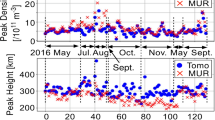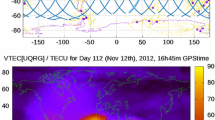Abstract
In this work, we introduce a new way of improving the sligthly best performing global ionospheric model (GIM) within the International GNSS Service, the UQRG produced by UPC-IonSAT with the TOMION dual-layer voxel model solved with ground-based dual-frequency carrier phase GPS data combined with kriging interpolation. This is done by increasing its vertical resolution consistently with the heights of the now involved GNSS and DORIS LEO receivers. This has allowed the synergestic combination of vessel-, LEO- and ground-based measurements, providing an increase of the VTEC accuracy at global scale in large regions with sparse GPS ground-based data. The performance of the new resulting multiTOMION model is illustrated with a first application to one of the infrequent datasets, including the whole day of June 5, 2017, with all the involved input data collocated, in particular the vessel-based GNSS ones. The results show in particular: (1) an overall GIM improvement of 3% in standard deviation versus independent JASON-3 VTEC measurements when LEO- and ground- based GPS data are combined with DORIS measurements. And (2) a local improvement of 6–9% in performance versus observed differences of STEC from independent GPS receivers placed at several hundreds of km far from the vessel.












Similar content being viewed by others
Data availability statement
The data that support the findings of this study are available from the corresponding author upon reasonable request.
References
Alizadeh M, Schuh H, Todorova S, Schmidt M (2011) Global ionosphere maps of VTEC from GNSS, satellite altimetry, and Formosat-3/COSMIC data. J Geod 85(12):975–987
Chen P, Yao Y, Yao W (2017) Global ionosphere maps based on GNSS, satellite altimetry, radio occultation and DORIS. GPS Solut 21(2):639–650
Dettmering D, Schmidt M, Heinkelmann R, Seitz M (2011) Combination of different space-geodetic observations for regional ionosphere modeling. J Geod 85(12):989–998
Dettmering D, Limberger M, Schmidt M (2014) Using DORIS measurements for modeling the vertical total electron content of the earths ionosphere. J Geod 88(12):1131–1143
Hernández-Pajares M, Juan J, Sanz J (1997) Neural network modeling of the ionospheric electron content at global scale using GPS data. Radio Sci 32(3):1081–1089
Hernández-Pajares M, Roma-Dollase D, Krankowski A, García-Rigo A, Orús-Pérez R (2017) Methodology and consistency of slant and vertical assessments for ionospheric electron content models. J Geod 91:1405–1414
Hernández-Pajares M, Roma-Dollase D, Garcia-Fernàndez M, Orus-Perez R, García-Rigo A (2018) Precise ionospheric electron content monitoring from single-frequency GPS receivers. GPS Solut 22(4):102
Li Z, Yuan Y, Wang N, Hernandez-Pajares M, Huo X (2015) SHPTS: towards a new method for generating precise global ionospheric TEC map based on spherical harmonic and generalized trigonometric series functions. J Geod 89(4):331–345
Li Z, Wang N, Hernández-Pajares M, Yuan Y, Krankowski A, Liu A, Zha J, García-Rigo A, Roma-Dollase D, Yang H et al (2020) IGS real-time service for global ionospheric total electron content modeling. J Geod 94(3):1–16
Liu T, Zhang B, Yuan Y, Zhang X (2020) On the application of the raw-observation-based PPP to global ionosphere VTEC modeling: an advantage demonstration in the multi-frequency and multi-gnss context. J Geod 94(1):1–20
Lyu H, Hernández-Pajares M, Nohutcu M, García-Rigo A, Zhang H, Liu J (2018) The Barcelona ionospheric mapping function (BIMF) and its application to northern mid-latitudes. GPS Solut 22:1–13
Roma-Dollase D, Hernández-Pajares M, Krankowski A, Kotulak K, Ghoddousi-Fard R, Yuan Y, Li Z, Zhang H, Shi C, Wang C, Feltens J, Vergados P, Komjathy A, Schaer S, García-Rigo A, Gómez-Cama JM (2018) Consistency of seven different GNSS global ionospheric mapping techniques during one solar cycle. J Geod 92(6):691–706
Todorova S, Hobiger T, Schuh H (2008) Using the global navigation satellite system and satellite altimetry for combined global ionosphere maps. Adv Space Res 42(4):727–736
Tomaszewski D, Wielgosz P, Rapiński J, Krypiak-Gregorczyk A, Kaźmierczak R, Hernández-Pajares M, Yang H, OrúsPérez R (2020) Assessment of centre national d’études spatiales real-time ionosphere maps in instantaneous precise real-time kinematic positioning over medium and long baselines. Sensors 20(8):2293
Yao Y, Liu L, Kong J, Zhai C (2018) Global ionospheric modeling based on multi-GNSS, satellite altimetry, and Formosat-3/COSMIC data. GPS Solut 22(4):104
Zhang B, Ou J, Yuan Y, Li Z (2012) Extraction of line-of-sight ionospheric observables from gps data using precise point positioning. Sci China Earth Sci 55(11):1919–1928
Zhang B, Teunissen PJ, Yuan Y, Zhang H, Li M (2018) Joint estimation of vertical total electron content (VTEC) and satellite differential code biases (SDCBS) using low-cost receivers. J Geod 92(4):401–413
Zhang B, Teunissen PJ, Yuan Y, Zhang X, Li M (2019) A modified carrier-to-code leveling method for retrieving ionospheric observables and detecting short-term temporal variability of receiver differential code biases. J Geod 93(1):19–28
Acknowledgements
This work has been developed thanks to the Atmosfiller project funded by the European Space Agency (ESA) and leaded by Rokubun S.L. The part of the study related with Galileo data was possible thanks to the former contributions of Dr. David Roma-Dollase. The authors are very grateful to the University of Hamburg and the Maria F. Merian crew for the vessel GNSS data. The authors also acknowledge to the International GNSS Service and related agencies the most part of the data used in this study.
Author information
Authors and Affiliations
Contributions
MHP participated in the design of the study and did the data analysis. HL wrote the manuscript. MGF and ROP participated in the design of the study and helped to improve the manuscript.
Corresponding author
Rights and permissions
About this article
Cite this article
Hernández-Pajares, M., Lyu, H., Garcia-Fernandez, M. et al. A new way of improving global ionospheric maps by ionospheric tomography: consistent combination of multi-GNSS and multi-space geodetic dual-frequency measurements gathered from vessel-, LEO- and ground-based receivers. J Geod 94, 73 (2020). https://doi.org/10.1007/s00190-020-01397-1
Received:
Accepted:
Published:
DOI: https://doi.org/10.1007/s00190-020-01397-1




